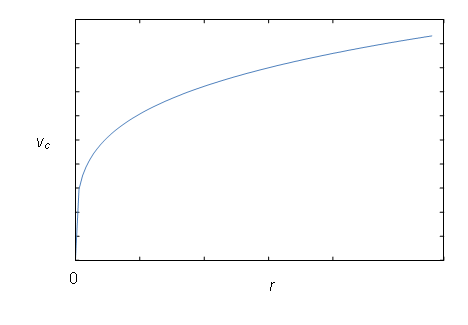“By about 1880 physics was serene; most phenomena could be explained by Newtonian mechanics, Maxwell’s electromagnetic theory, thermodynamics, and Boltzmann’s statistical mechanics. Only a few problems appeared unsolved.”
— Encarta Encyclopedia (2006) —
7
Modification
of Gravity Model
In this chapter, we will show how to prepare our simulation for alternative gravity model. Explaining rotation curves at large galactic radii remains an open question in galaxy dynamics. Visible matter itself under the influence of Newtonian gravity and dynamics cannot explain the rotation of visible material in the galaxy. A lot of dark matter (DM) must be introduced into calculations to match the observational evidence of flat rotation curve in disk galaxies. This nonluminous material cannot be directly detected by observing any form of electromagnetic radiation and its existence is suggested by theoretical considerations.
The Newtonian theory and Einstein’s theory of General Relativity (GR) had been well tested on a solar system scale and form the part of established physics. Experimentally known forms of matter under the assumption of the validity of established physics on scales greater than solar system cannot explain
· a disk and some elliptical galaxy rotation (Romanowsky, 2006),
· galaxies grouped together into clusters (large scale structure of the universe, LSS),
· the extent of the X-ray-emitting region of gas and the temperature of the gas in galaxy clusters,
· an amount of light from a background cluster of galaxies bended by another cluster of galaxies in the foreground (through gravitational lensing) and
· the shape of anisotropy spectrum of cosmic microwave background (CMB) radiation.
These problems can be roughly explained by introducing an additional matter that does not radiate. The dark matter is partially composed of gas, dust, planets, brown dwarfs, black holes, and other ordinary (baryonic) matter that is very low-radiating and is bellow detection abilities of observational astronomy. However, cosmology constrains the amount of this baryonic matter in the universe to about 20 % of overall mass content of the universe. Instead, according to the standard model, the most of the matter in the universe must be of non-baryonic origin. In the following text, I will use the term “dark matter” as substitution for the “non-baryonic dark matter”.
Several issues complicate a picture with the (non-baryonic) dark matter on galactic scales (CDM crisis). Computer simulations with the dark matter (e.g. Springel et al., 2006) show in galaxies
· steep density cores (density grows in a cusp towards infinity as one approaches the halo center),
· hundreds of satellite galaxies (dark galaxies) and
· small disk sizes.
On contrary, observations show
· shallow density profiles,
· tens of satellite galaxies (missing satellites problem) and
· large disk sizes.
Moreover, the distribution of known MW satellites, including recently discovered ones, was found to be inconsistent with an isotropic or prolate dark matter halo distribution at a 99.5 % level (Kroupa et al., 2005). On super-galactic scales, the predictions of LCDM model simulations match observations perfectly.
Theoreticians motivated primarily by explaining nature on small scales predict the existence of dark particles. The leading candidate for the dark matter is the neutralino from super-symmetric (SUSY) scenarios. Dark matter particle can collide with baryons and reveal its presence in laboratory detectors. Experiments at the Large Hadron Collider (LHC) at the European Organization for Nuclear Research (CERN) will look for indirect evidence of such particles once finished in 2007. Until now, however, all projects trying to detect the dark matter particles directly or indirectly failed to proof the existence of dark particles that could be able to explain 80 % of missing matter[62].
Since there is no experimental evidence for the dark matter, reasonable alternative ways should be explored by physicists. It is possible that what we have interpreted as the evidence for the dark matter is, in fact, the evidence for the breakdown of Newton’s (and Einstein’s) gravity and dynamics. We should be cautious about accepting the idea of dark matter and remain open minded to other possibilities.
The Newtonian theory appears to have several limitations. An example of this limitation is the orbit of the planet Mercury. This planet follows an elliptical orbit, where every completed rotation around the Sun is shifted with an constant factor from the preceding trajectory. This can be fully explained by Newton’s parent theory: Einstein’s theory of General Relativity. However, even GR is not the final theory and has known limitations on quantum scales and may have its limitations on galaxy scales as well. GR is considered to be a low energy approximation of some other parental theory (e.g. string/M-theory).
When there is a discrepancy between the theory and observations in physics then it is necessary to start looking for a new theory, which as the (small) subset contains properties of previous theories, which is in correspondence with new observations and which adds new predictions. Hence, there is a possibility that observed inconsistency comes from our imperfect models of gravity and dynamics, so that Newton’s law of gravity is not valid on large scales.
7.2 Modified Newtonian Dynamics
Perhaps the most interesting alternative model is the Modified Newtonian Dynamics (MOND) introduced by Milgrom (1983). Milgrom suggested a phenomenological explanation of the flat rotation curve through the modification of Newton’s laws without the need of DM. MOND’s assumption is that galaxies do not have significant DMH. MOND essentially says that in order to reproduce the flat rotation curves, the real acceleration of bodies (stars) must be significantly greater for small accelerations than that predicted by the Newtonian theory of gravity.
MOND assumes that there is a characteristic
acceleration ![]() , under which the gravity is
more powerful than is predicted by Newton’s theory. If a Newtonian acceleration
, under which the gravity is
more powerful than is predicted by Newton’s theory. If a Newtonian acceleration
![]() is smaller than
is smaller than ![]() , gravity is stronger than Newton’s theory predicts. Real acceleration is then
, gravity is stronger than Newton’s theory predicts. Real acceleration is then ![]() .
The value of
.
The value of ![]() can be experimentally
determined from the rotation curve to fit observations[63]. If
acceleration
can be experimentally
determined from the rotation curve to fit observations[63]. If
acceleration ![]() is greater than
is greater than ![]() , Newton’s value of
acceleration is preserved. MOND is therefore modification for small
accelerations. It is very hard to test MOND in the laboratory since the acceleration
on the surface of the Earth is always much larger than
, Newton’s value of
acceleration is preserved. MOND is therefore modification for small
accelerations. It is very hard to test MOND in the laboratory since the acceleration
on the surface of the Earth is always much larger than ![]() , thus always entering
Newtonian regime.
, thus always entering
Newtonian regime.
As the notion suggests, MOND is the modification of Newton’s second law and is mathematically expressed for bodies with the constant mass as
|
|
(7.1) |
where ![]() is a mass
of a body,
is a mass
of a body, ![]() is the Newtonian
acceleration and
is the Newtonian
acceleration and ![]() is the Newtonian force.
MOND changes Equation 7.1 into a new form (Milgrom, 1983)
is the Newtonian force.
MOND changes Equation 7.1 into a new form (Milgrom, 1983)
|
|
(7.2) |
where ![]() was substituted
with
was substituted
with
|
|
(7.3) |
Here ![]() is
MONDified (“more accurate”) acceleration and
is
MONDified (“more accurate”) acceleration and ![]() is
an interpolation function. The interpolation function is chosen in a way that
acceleration becomes
is
an interpolation function. The interpolation function is chosen in a way that
acceleration becomes
|
|
(7.4) |
|
|
In everyday life is ![]() ,
therefore
,
therefore ![]() and Equation 7.2 is reduced
back to the classical Newtonian form (Eq. 7.1). Between these two extreme cases,
some interpolated behavior is applied. Milgrom (1983) suggested between these
regimes interpolation function
and Equation 7.2 is reduced
back to the classical Newtonian form (Eq. 7.1). Between these two extreme cases,
some interpolated behavior is applied. Milgrom (1983) suggested between these
regimes interpolation function
|
|
(7.5) |
where
|
|
(7.6) |
Initial motivation for introducing MOND was the flat rotation curve of disk galaxies. We can start with Newton’s law of gravity in classical formulation and with the MOND’s modification of Newton’s second law of motion
|
|
(7.7) |
When we take into account that ![]() and therefore
and therefore ![]() then we get
then we get
|
|
(7.8) |
from which can be expressed
|
|
(7.9) |
For a circular motion is a centripetal
(centrifugal) force ![]() , so that
, so that ![]() . Then
. Then
|
|
(7.10) |
and the circular velocity is finally
|
|
(7.11) |
It can be seen that the circular velocity is
independent on the distance ![]() from the
center. This consequently leads to a conclusion that rotational curve for
from the
center. This consequently leads to a conclusion that rotational curve for ![]() must be slightly increasing.
We can also immediately determine the characteristic acceleration
must be slightly increasing.
We can also immediately determine the characteristic acceleration ![]() from the observed circular
velocity.
from the observed circular
velocity.
Simulations and observations of Bissantz et al.
(2004) referred about the absence of the DM in the Milky Way’s galactic bulge,
where is ![]() and Newtonian gravity
applies. At larger distance, acceleration is smaller and enters into the MOND
regime.
and Newtonian gravity
applies. At larger distance, acceleration is smaller and enters into the MOND
regime.

Figure 7–1: The rotation curve in MOND.
Rotation curves of disk galaxies are not the only evidence of the dark matter. MOND should be able to explain all problems listed in Chapter 7.1 consistently. However, MOND is not without difficulties.
· An original formulation of MOND (Milgrom, 1983) violates basic principles underlying physics (Felten, 1984): The Newton’s third law and linear momentum are not conserved (an acceleration is not inversely proportional to a mass, there is no symmetry between a galaxy and a test mass); Milgrom and Bekenstein (1984) explained these shortcomings.
· MOND was introduced to relief the universe of the dark matter; however, it cannot explain the motion of galaxies in rich clusters, where a lot of the dark matter is needed anyway.
· Minchin et al. (2005) claim to have detected an HI source in the Virgo Cluster that could be a dark halo without shining stellar galaxy inside. Others claim that this detection is little more than tidal debris, originating from the nearby galaxy NGC 4254.
MOND was also for a long time seen as an isolated theory. However, Bekenstein (2004) invented its parent theory. Bekenstein published a relativistic version of MOND called tensor-vector-scalar theory (TeVeS), essentially an extension of GR. TeVeS reduces to Einstein’s theory for high speeds and large accelerations, to Newtonian gravity for low speeds and small accelerations and to MOND when accelerations are even smaller. It is possible that some unknown fundamental physics (e.g. string/M-theory) is reducing to TeVeS in a suitable limit. Both hypotheses, dark matter and gravity modification, have their pros and cons. Future experiments will shed more light into this darkness.
7.4 Modification to gravity model
We now want to find a relationship between the Newtonian and MONDian acceleration so that modifications of our simulation code can be made. Equation 7.3 can be manipulated as follows
|
|
(7.12) |
One now only needs to solve
|
|
(7.13) |
to get ![]() as
a function of
as
a function of ![]() . Relationship
between the Newtonian
. Relationship
between the Newtonian ![]() and MONDian
acceleration
and MONDian
acceleration ![]() is then (e.g. Read and
Moore, 2005)
is then (e.g. Read and
Moore, 2005)
|
|
(7.14) |
Equation 7.14 can be used in N-body modeling of gravity interaction instead of Newtonian gravitational acceleration from Chapter 4. The generation of initial conditions of isolated galaxies from Chapter 5 should also take into account the modification of Poisson’s equation. However, for initial investigations, we can leave it without changes.
We will create a Kuzmin’s disk with our classical
initial conditions generation program. We will evolve initial conditions with the
Barnes-Hut N-body simulation code in MONDified gravity mode with the opening angle ![]() and the softening
length
and the softening
length ![]() .
.

Table 7–1: Simulation parameters of the Kuzmin’s model.
The timestep was set equal to ![]() and the overall simulation
covers
and the overall simulation
covers ![]() .
.
|
|
|
|
|
Start |
205 million years |
409 million years |
|
|
|
|
|
|
|
|
|
614 million years |
818 million years |
1.02 billion years |
Figure 7–2: A time sequence for the hot Kuzmin’s disk in the xy plane evolved with the MONDified Barnes-Hut N-body algorithm.
|
|
|
Start |
|
|
|
205 million years |
|
|
|
409 million years |
|
|
|
614 million years |
|
|
|
818 million years |
|
|
|
1.02 billion years |
Figure 7–3: A time sequence for the hot Kuzmin’s disk in the yz plane evolved with the MONDified Barnes-Hut N-body algorithm.
The shrinking of the disk can be seen on Figure 7–3 as the result of a more powerful gravity in Milgrom’s MOND.
7.5 Concluding remarks
In Chapter 7, we have shown how to prepare our simulation for the alternative gravity model. We have learned that the simulation of a galaxy in Modified Newtonian Dynamics (MOND) theory can be performed with at least the same result as the simulation in Newton’s theoretical framework. Cosmological large-scale dark matter computer simulations performed by other authors agree with the observations, while the results on galaxy scales are inconsistent. These simulations with dark matter may miss some important small scale physics of both baryonic and non-baryonic matter that is not resolved with a current resolution of cosmological simulations and computer models, while the standard model can be accurate.
One should be cautious, however, as the theory is stretched and adapted to fit the evidence, or facts are carefully selected to fit the theory. We learned from the history of physics that models of nature usually comprehended a lot of things accurately, but also usually missed important big ones. Mordehai Milgrom and others has done interesting work that healthy competes with dark matter theory. In any case, even if MOND should be revealed as an incorrect theory, it serves as a good exercise for galaxy modeling. We should keep in mind that “laws of physics” are not an accurate description of nature.



















